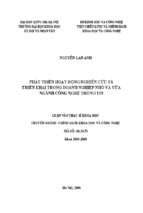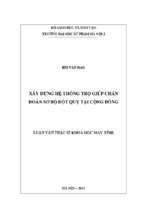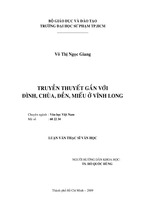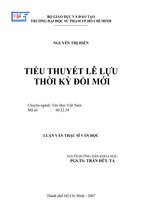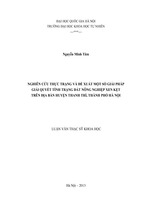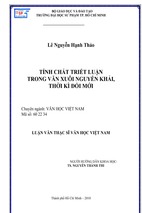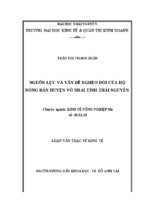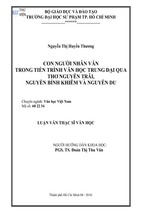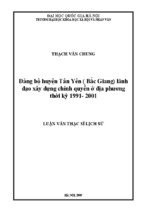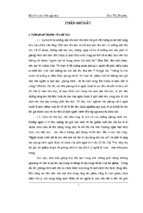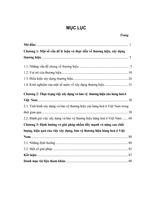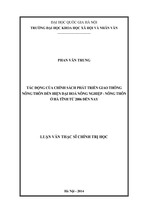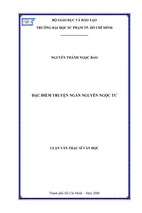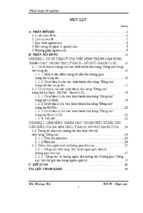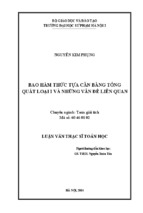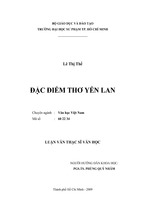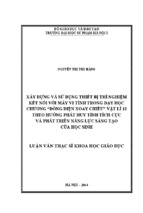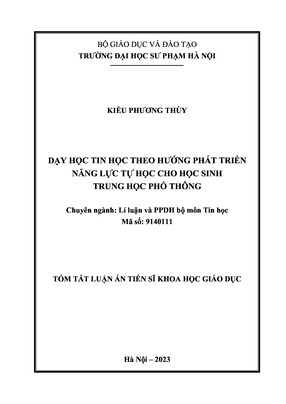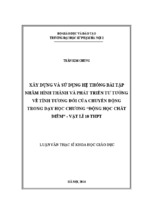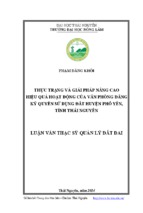VIETNAM NATIONAL UNIVERSITY, HANOI
University of Languages and International Studies
-----o0o-----
HOANG THI NGOC DIEM
TV NEWS IN ENGLISH AND VIETNAMESE
(Phân tích bản tin truyền hình tiếng Anh và tiếng Việt)
Major: English Linguistics
Code: 62 22 15 01
A Thesis Submitted in Total Fulfillment of the Requirements for the Degree
of Doctor of Philosophy
Supervisors:
Ha Cam Tam, PhD
Assoc. Prof. Tran Xuan Diep (PhD)
Hanoi - 2015
i
STATEMENT OF AUTHORSHIP
Except where reference is made in the text of the dissertation, no other person’s work
has been used without due acknowledgement in the main text of the dissertation.
This dissertation has not been submitted for the award of any degree of diploma in any
other tertiary institution.
Hoang Thi Ngoc Diem
Date:
ii
ACKNOWLEDGEMENTS
I am indebted to many people without whose help the present thesis could not have been
completed.
First of all, I would like to express my great gratitude to my supervisors Dr. Ha Cam
Tam and Assoc. Prof. Tran Xuan Diep for their valuable guidance, insightful comments
and endless support.
I wish to express my sincere thanks to the staffs of Post Graduate Department,
particularly Assoc. Prof. Le Hung Tien (PhD), Dean of the Department, Mrs. Ngo
Thanh Thuy (M.A), Mr. Do Ba Quy (M.A) and Mrs. Nguyen Thi Phuong Nhung for
their assistance in the finalization of the dissertation.
I also would like to extend my deep and special thanks to my colleagues and friends,
whose help and encouragement were great contribution to the completion of the
dissertation.
I’m also indebted to my course mates Mrs. Nguyen Thi Quyet and Mrs. Tran Thi Ngoc
Lien for their support in publications and reference materials.
Finally, I owe the completion of this dissertation to my parents, my husband and my
two children, who have always given me their understanding and encouragement
throughout my study. My special thanks are due to my husband for his software and
technical support.
To all mentioned, and to many more, my heart extends the warmest thanks.
iii
ABSTRACT
The dissertation aims at comparing and contrasting television news in English and
Vietnamese from cognitive approach with the assistance of corpus-based analysis
techniques. The main source of data is daily news from BBC World News and VTV1
channel, both covering the topic of natural disasters. The analytical framework is
centered on mental spaces and Figure-Ground theories. The study first provides in-depth
analysis regarding mental spaces in television news in English and Vietnamese, how
mappings are constructed to generate blended spaces. Secondly, research is conducted
on how Figure-Ground theory is illustrated in news language and what cognitive
differences there are between the two languages. The results show that there were
cognitive similarities and differences between the two sources of news stories in the
way of reporting news. Because cognition is embodied, the way reality (i.e. natural
disasters) was viewed and retold in news stories in each language had its own features.
In English news, the disastrous events were reported with more current and up-to-date
information. Details of the disasters were described with more facts, numbers and
directly from various points of view such as the news readers, the field reporters, region
correspondents and witnesses. In other words, it can be said that English news was more
direct, factive and objective. On the contrary, in Vietnamese news, stories were focused
more on the consequences. The information included not only the events themselves but
also subjective advice, prediction and evaluation of the reporters and news makers.
Description of the events was also concerned with subjective attitudes, compared with
human feelings and endurance. Human sufferings and feelings were integrated while
news stories were told. In summary, The English news generally is more factive,
reported from the view of the outsiders. The event is focused on itself and news has the
function of objectively reporting events with full and immediate details. Meanwhile,
Vietnamese news is reported from the view of the insiders. The ego is seen as the
reference for description, prediction, advice and evaluation.
iv
TABLE OF CONTENTS
PART I – INTRODUCTION
1. Rationale ............................................................................................................................. 1
2. Objectives of the study ....................................................................................................... 3
3. Scope of the study .............................................................................................................. 3
4. Contribution of the study .................................................................................................... 3
5. Organization of the dissertation.......................................................................................... 4
PART II - DEVELOPMENT
CHAPTER 1: LITERATURE REVIEW
1.1. Background of news language ......................................................................................... 5
1.1.1. Historical background of news......................................................................... 5
1.1.2. Television news broadcast ............................................................................... 6
1.1.2.1. Definitions and features of news ............................................................... 6
1.1.2.2. Television in comparison with other channels of communication .............. 9
1.1.3. News genre.................................................................................................... 10
1.1.4. Approaches to news language ........................................................................ 14
1.1.5. Previous studies on news ............................................................................... 17
1.1.5.1. Preceding studies on news texts .............................................................. 17
1.1.5.2. Previous studies on news from corpus-based and cognitive approach ...... 18
1. 2. Cognitive linguistics ..................................................................................................... 19
1.2.1. Overview ....................................................................................................... 19
1.2.2. The nature of cognitive linguistics ................................................................. 22
1.2.2.1. Generalization commitment .................................................................... 22
1.2.2.2. Cognitive commitment............................................................................ 26
1.2.2.3. The embodied mind ................................................................................ 27
1.2.2.4. Cognitive approach to semantics and grammar........................................ 28
1.2.3. Cognitive semantics....................................................................................... 29
1.3. Mental spaces ................................................................................................................ 33
1.3.1. Definition and categorization ......................................................................... 33
1.3.2. Speech space ................................................................................................. 37
1.3.3. Space builders ............................................................................................... 39
1.4. Conceptual blending ...................................................................................................... 40
1.4.1. Basic concepts ............................................................................................... 40
1.4.2. Metaphor, metonymy and blending................................................................ 46
1.5. Figure and Ground ......................................................................................................... 47
1.5.1. Background concepts ..................................................................................... 47
1.5.2. Figure and Ground in a single clause ............................................................. 50
v
1.5.3. Figure and Ground in a complex sentence...................................................... 51
1.5.4. The grammatical relations of Figure and Ground ........................................... 54
CHAPTER 2: RESEARCH METHODOLOGY
2.1. Research questions ........................................................................................................ 56
2.2. Analytical framework – corpus-assisted cognitive semantics ....................................... 56
2.5.1. Cognitive framework ..................................................................................... 56
2.5.2. Corpus assisted analysis................................................................................. 58
2.3. Data collection ............................................................................................................... 59
2.3.1. Criteria for collecting data ............................................................................. 59
2.3.2. Corpus design ................................................................................................ 60
2.3.3. Representativity of the data ........................................................................... 60
2.4. Methods of the study ..................................................................................................... 61
2.5 Data collection instruments ............................................................................................ 63
2.6. Data analysis procedure ................................................................................................. 64
CHAPTER 3: MENTAL SPACES IN ENGLISH AND VIETNAMESE NEWS
3.1. Speech space .................................................................................................................. 66
3.1.1. Findings from English news .......................................................................... 66
3.1.2. Findings from Vietnamese news .................................................................... 73
3.1.3. Discussion ..................................................................................................... 80
3.2. Hypothetical spaces ....................................................................................................... 83
3.2.1. Findings from English news .......................................................................... 83
3.2.2. Findings from Vietnamese news .................................................................... 87
3.2.3. Discussion ..................................................................................................... 94
CHAPTER 4: CONCEPTUAL BLENDING IN ENGLISH
AND VIETNAMESE NEWS
4.1. Condition and comparison ............................................................................................. 98
4.1.1. Findings from English news .......................................................................... 98
4.1.2. Findings from Vietnamese news .................................................................. 101
4.1.3. Discussion ................................................................................................... 105
4.2. Conceptual blending with occurrence verbs................................................................ 105
4.2.1. Findings from English news ........................................................................ 106
4.2.2. Findings from Vietnamese news .................................................................. 107
4.2.3. Discussion ................................................................................................... 109
4.3. Conceptual blending in imagery descriptions ............................................................. 109
CHAPTER 5: FIGURE AND GROUND
IN ENGLISH AND VIETNAMESE NEWS
5.1. Findings from English news ........................................................................................ 113
5.2. Findings from Vietnamese news ................................................................................. 117
vi
5.3. Discussion.................................................................................................................... 123
PART III - CONCLUSION AND IMPLICATIONS
1. Summary of major findings and conclusion ................................................................... 128
2. Implications .................................................................................................................... 131
3. Suggestions for further study.......................................................................................... 137
PUBLICATIONS AND PROJECTS RELATED TO THE DISSERTATION .................. 138
Bibliography ....................................................................................................................... 140
Appendix 1: Data export – Key words in context (KWIC) ....……………………………...I
Appendix 2: Raw analysis of speech spaces.................. ………………................... XXVIII
Appendix 3: English collocations for natural disasters …………….……..........…...... XLI
Appendix 4: Vietnamese collocations for natural disasters........................................XLIV
vii
LIST OF FIGURES, TABLES AND GRAPHS
Figure 1: Some members of the category “cup”........................................................... 23
Figure 2: Inputs and generic space .............................................................................. 41
Figure 3: Blended space .............................................................................................. 42
Figure 4: Figure – Ground examples ........................................................................... 48
Figure 5: Speech space type 1 in English news ............................................................ 71
Figure 6: Speech space type 2 in English news ............................................................ 71
Figure 7: Speech space type 3 in English news ............................................................ 72
Figure 8: Speech space type 1 in Vietnamese news ..................................................... 78
Figure 9: Speech space type 2 in Vietnamese news ..................................................... 79
Figure 10: Speech space type 3 in Vietnamese news ................................................... 79
Figure 11: Example 1 - blended space in English news ............................................... 99
Figure 12: Example 2 - blended space in English news ............................................. 100
Figure 13: Example of blended space in Vietnamese news ........................................ 104
Figure 14: Example 1 - Conceptual blending in English news with metaphors .......... 109
Figure 15: Conceptual blending in Vietnamese news................................................. 111
Figure 16: Example 2 - Conceptual blending in English news with metaphors .......... 112
Figure 17: Similarity of Figure and Ground between English and Vietnamese news .. 123
Figure 18: Difference of Figure and Ground between English and Vietnamese news . 126
Table 1: Speech verbs and quotation in English news .................................................. 67
Table 2: Senders in English news ................................................................................ 68
Table 3: Speech spaces in English news ...................................................................... 69
Table 4: Speech verbs and quotation in Vietnamese news ........................................... 74
Table 5: Senders in Vietnamese news.......................................................................... 75
Table 6: Speech spaces in Vietnamese news ................................................................ 75
viii
Table 7: Comparison of quotations in English and Vietnamese news........................... 80
Table 8: Comparison of senders between English news and Vietnamese news ............ 81
Table 9: Comparison of speech spaces in English and Vietnamese news ..................... 82
Table 10: Advice and command in English news ........................................................ 83
Table 11: Predicting structures in English news .......................................................... 84
Table 12: Concordance of prediction in English news ................................................. 84
Table 13: Estimation expressions in English news ....................................................... 85
Table 14: Concordance of “at least” ............................................................................ 86
Table 15: Evaluation expressions in English news ....................................................... 87
Table 16: Advice in Vietnamese news ......................................................................... 88
Table 17: Concordance of “phải” ................................................................................ 89
Table 18: Prediction expressions in Vietnamese news ................................................. 90
Table 19: Concordance of ‘có nguy cơ” ...................................................................... 91
Table 20: Estimation expressions in Vietnamese news ................................................ 91
Table 21: Concordance of “khoảng”............................................................................ 92
Table 22: Evaluation in Vietnamese news ................................................................... 93
Table 23: Concordance of “kinh hoàng” ...................................................................... 94
Table 24: Comparison of advice and command between English and Vietnamese news
................................................................................................................................... 94
Table 25: Comparison of prediction and possibility between English and Vietnamese
news ........................................................................................................................... 96
Table 26: Comparison of quantity estimating expressions between English news and
Vietnamese news ........................................................................................................ 96
Table 27: Condition and comparison structures in English news.................................. 98
Table 28: Conditional and comparative structures in Vietnamese news ..................... 101
Table 29: Concordance of “nhất” .............................................................................. 102
Table 30: Concordance of như” ................................................................................. 102
Table 31: Verbs in English news ............................................................................... 106
ix
Table 32: Concordance of “hit” ................................................................................. 107
Table 33: Verbs in Vietnamese news ......................................................................... 108
Table 34: Concordance of “cướp đi” ......................................................................... 108
Table 35: Imagery language in English and Vietnamese news ................................... 110
Table 36: Concordance of “fading hope” ................................................................... 110
Table 37: Concordance of “rốn lũ” ............................................................................ 110
Table 38: Connectives in English news ..................................................................... 116
Table 39: Connectives in Vietnamese news ............................................................... 122
Table 40: Figure – Ground comparison between Vietnamese and English news ........ 125
Table 41: Comparison of occurrence verbs between Vietnamese and English news ... 125
Table 42: Concordance of “of the earthquake” .......................................................... 133
Table 43: COCA sample KWIC ................................................................................ 134
Graph 1: Comparison of speech spaces in English and Vietnamese news .................... 82
Graph 2: Comparison of advice and command between English and Vietnamese news 95
Graph 3: Comparison of prediction and possibility between English and Vietnamese
news ........................................................................................................................... 96
1
PART I - INTRODUCTION
1. Rationale
The media has now become one of the principal means of getting information about the
world. Not only for information, are the media also used for various purposes including
entertainment, education, national identity enhancement or even political ones. Among
media channels, television seems to be increasingly popular and favoured as access to
television is widening to everyone and every corner of the world. It is largely believed
that the media are always there, and have come to be taken for granted as an integral
part of most people’s lives. With its crucial role, the power of the media cannot be
denied. They are a “site for the production and circulation of social meanings, i.e. to a
great extent the media decide the significance of things that happen in the world for any
given culture” (Thornborrow, 2004:56).
Within the research circle, the media has been explored a great deal so far. With regards
to TV news alone, much interest has been shown in the field of linguistics. Hohn (1995)
investigated linguistic features of BBC Radio 1 and Radio 4 to find out the similarities
and differences between them. In 2006, Luginbuehl presented the result of comparing
news stories in American and Swiss TV news since the 60s in view of “culturality”. His
conclusion stated that Swiss TV news showed a detached way of reporting while CBS
news displayed close and immediate reports; cultural differences were also found in
different journalistic roles. At the same time, Senokozlieva and her co-researchers
(2006) also examined the relationship between culture and selected formal
characteristics of newscasts from three regions: The United States of America, Germany
and the Arab world. Their findings showed that in collectivist societies like the Arab
world, there were more displays of groups or individuals who are contextualized by
others than in the individualistic US. Most recently, Shi Hong-mei (2008) conducted a
critical analysis on turn-taking organization in English news interviews in China and her
results showed the influence of the power and ideology on turn-taking; the interviewer
with the institutional role, could interrupt or insert their turn-taking to control, direct the
talk as intended plan.
2
Apart from the findings that those authors have made about news above, news and
television news are also of great importance in reasoning the way human mind sees
events and representing them via language. This can be a great opportunity to
theoretically and practically contribute to the field of cognitive linguistics. However, to
the best of my knowledge, comprehensive investigations into news features of
Vietnamese and British broadcasting from cognitive linguistics seem to be rare.
From pedagogical approach, newscasts in general are a rich source of authentic
materials for foreign language learning and teaching. News is practically integrated into
textbooks, English software, interactive websites for e-learning, and are used to develop
all skills as well as particular subjects like translation and interpretation. BBC itself also
opens
a
free
link
for
English
(http://www.bbc.co.uk/worldservice/learningenglish/index.shtml)
with
learners
various
activities. Besides, access to visual original news is undoubtedly becoming common for
self-learning. However, for Vietnamese learners of English, the use of news broadcasts
in learning seems spontaneous. The news language itself as well as differences in news
broadcasts between British culture and Vietnamese culture has not yet been introduced
systematically to learners and teachers. Newscasts are merely seen by many as an
authentic source for practice or one of the accesses to native speakers or real-life
English.
Again, the importance of news reports in general and television newscasts in particular
cannot be denied in our everyday lives, language learning as well as in scholarly
researching. It is also a fertile source of data for various branches of social sciences such
as linguistics, semiotics, and discourse analysis (van Dijk, 1988:109). Despite the
increasing popularity of television news broadcast and its important functions in
shaping human perception as well as reasoning the relationship between human mind,
meaning construction and language presentation, from a look into previous studies on
news broadcasts and an investigation in practical applications of news in teaching, to the
best of my knowledge, investigations into comparing news of Vietnamese and British
broadcasting from cognitive approach seem few and far between. Basing on that
account, the author would like to conduct an investigation of VTV1 news and BBC
World News products to make a contribution to the large gap of news language
analysis, hence give suggestions for English language learning and teaching. The author
3
does hope the results of the study will be of potential concern to those who have interest
in linguistics, corpus linguistics, cognitive linguistics, mass communication and intercultural study.
2. Objectives of the study
The objectives of this study are:
-
To explore the ways by which mental spaces and conceptual blending are
realized in English and Vietnamese television news broadcasts,
-
To find out the similarities and differences between English and Vietnamese
television news broadcasts with regards to mental spaces and conceptual
blending,
-
To explore Figure-Ground presentation in English and Vietnamese news
broadcasts, and finally
-
To find out the similarities and differences between English and Vietnamese
television news broadcasts with regards to Figure-Ground presentation.
3. Scope of the study
Television news broadcasts as a part of the media are an endless source of data for
various study approaches. The thesis focuses on television news in English and
Vietnamese covering the topic of natural disasters. The reasons for the choice of news
topic are discussed in chapter 2, part II of this dissertation. The main source of data is
daily news from BBC World News channel and VTV1 newscasts. News broadcasts are
studied from cognitive linguistics perspective with the assistance of corpus-based
analysis techniques. The analytical framework is centered on mental spaces, conceptual
blending and Figure-Ground theories. Other news topics, other sources of news as well
as other linguistic approaches to news language fall beyond the scope of this study.
4. Contribution of the study
Theoretically, the study reviews and systemizes important principles and characteristics
in cognitive linguistics. It investigates a research area that few Vietnamese researchers
have ever explored, that is news language from cognitive perspective. Particularly,
4
theories related to mental spaces, Figure-Ground relationship, to my knowledge, have
not been applied in analyzing and comparing news language.
Practically, the study first is expected to provide in-depth results regarding mental
spaces in television news in English and Vietnamese, how mappings are constructed to
generate blended spaces. The second practical contribution is made via the detailed
research on how Figure-Ground theory is illustrated in news language and what
cognitive differences there were between the two languages. The study then contributes
significant practical implications to related fields of linguistics, cognitive linguistics,
language learning and teaching and translation.
In terms of methodology, a method that has not been used in previous studies on news is
applied, that is corpus-assisted analysis to yield major research results. This method is
proved to bring valid and reliable findings. It includes both qualitative and quantitative
techniques in accessing and processing data.
5. Organization of the dissertation
Part I is the Introduction of the study. Emphasis is given to the issue of the research foci
of the dissertation. In so doing it sets the scene for the study of news in the remainder of
the dissertation.
Part II, the Development, consists of 5 chapters.
In chapter 1, fundamental issues of cognitive linguistics are reviewed. Then specific
theories in mental spaces and Figure-Ground are introduced.
Chapter 2 offers an overview of the methodology of the study. It includes corpus
building, coding system, data collection instruments and the like. The not less important
part of the chapter is a proposal of the analytical framework, based on which the study
is conducted.
Chapter 3, 4 and 5 produce a detailed analysis of mental spaces and Figure-Ground
models in English and Vietnamese news.
Finally, conclusions are offered in part III. It summarizes major findings and presents
suggestions for further research and implications for English language teaching and
learning in Vietnam.
5
PART II - DEVELOPMENT
Chapter 1: literature review
1.1. Background of news language
1.1.1. Historical background of news
Central to the global spread of news as a genre and also in terms of content has been
news agency – the first global medium. News agencies started in the middle of the
nineteenth century (Machine & Leeuwen, 2007) to supply newspapers with news items
from across the world. Then, information became commodity, presented in a neutral
style to be saleable to editors of different political persuasion. Today’s news agencies
operate on the principle that “almost anything that passes as news in print, broadcasting
and electronic media is likely to have some financial implication for someone” (Machin
& Leeuwen, 2007:8). Many people still think of politics, culture and economics as
separate domains. In global media communication, they come together. In reference to
the issue of standardization, Machin and Leeuwen (2007) also assert that to sell editors,
news has to become politically neutral, pure information, pure fact. This approach,
which today is common in the world, was gradually developed and globally propagated
by the major news agencies. In the 1980s, satellite broadcasters, like other global
corporation, began to see profit in news spreading. It is argued that satellite TV allowed
other exporters of television programmes to enter the market (Machin and Leeuwen,
2007).
Notably, related to the issue of TV broadcasting, Marshall (2002:3) highlights that
“television, as a modern medium, operates in a production-text-audience cycle”. It is
mass communication produced not for specific individuals but for an unlimited number
of people. Therefore, it can be seen by a huge number of viewers simultaneously. Apart
from news agencies, the role of journalists in the modern time has taken more attention
than before. “The journalist has been not only the gatekeeper who filters the floods of
6
information into an orderly stream of news, but also the broker of social consensus who
shapes community’s attitudes” (Lewis, 2003:101)
Sociologists have shown that what is called “news” is quite an odd set of institutional
practices that must be understood in terms of its social and historical development. And
the context of news under investigation is a British and Vietnamese one. News itself,
and its associated practices, the organizations of its institutions, its format and genre,
have their origins particularly in British and Vietnamese culture, typical cognition
process and mind.
The above discussion about the history of news and its globalization process serves as a
very basic background which leads to the further discussion in the following parts.
1.1.2. Television news broadcast
1.1.2.1. Definitions and features of news
There have existed various concepts of news in different fields so far. In the definition
from BBC (Language of the media, 2003:2), a news report simply “gives details of a
news story and its purpose is to give the listener information in an interesting but
objective way”. According to NewsTalk & Text Research Group of Ghent University
(2009:4), news has two key characteristics that make a productive area for research and
understanding. Firstly, news is commonly defined through its relation to time. News is
about novelty, contemporary events, the most recent, should be timely, fresh and
pertinent. Secondly, news is all about retelling, intertextuality, and, by extension,
entextualization, that is, the extraction of meaning from one discourse and consequent
insertion of that meaning into another discourse. Interestingly, Van Dijk (1988:3) who
studies news as a type of text or discourse claims that the notion of news implies the
following concepts:
(1) New information about events, things or persons.
(2) A (TV or radio) program type in which news items are presented.
(3) A news item or news report, i.e., a text or discourse on radio, on TV or
in the newspaper, in which new information is given about recent
events.
7
The
focus
of
the
study
is
particularly
television
news,
that
is,
a
type of text or discourse as it is expressed in (3), used, or made public in such a news
medium or a public information carrier as TV. This medium is distinguished with print
media with its unique combination of visuality with both oral and written varieties of
language.
It can be said that of all concepts of news, the author particularly has interest in the two
key characteristics claimed by a group of researchers of Ghent University (2009) and
the definition given by Van Dijk (1988). They would be used as the light to look deeply
in news analysis with related features.
Interestingly, according to Bell (1991), Galtung & Ruge (1965) and Schlesinger (1987),
any event which is worth reporting as news needs to meet the following conditions:
-
Frequency: Events that occur suddenly and fit well with the news organization's
schedule are more likely to be reported than those that occur gradually or at
inconvenient times of day or night. Long-term trends are not likely to receive
much coverage.
-
Negativity: Bad news is more newsworthy than good news.
-
Unexpectedness: If an event is out of the ordinary it will have a greater effect
than something that is an everyday occurrence.
-
Unambiguity: Events whose implications are clear make for better copy than
those that are open to more than one interpretation, or where any understanding
of the implications depends on first understanding the complex background in
which the events take place.
-
Meaningfulness: This relates to the sense of identification the audience has with
the topic. "Cultural proximity" is a factor here -- stories concerned with people
who speak the same language, look the same, and share the preoccupations as
the audience receive more coverage than those concerned with people who
speak different languages, look different and have different preoccupations.
-
Reference to elite nations: Stories concerned with global powers receive more
attention than those concerned with less influential nations.
8
-
Reference to elite persons: Stories concerned with the rich, powerful, famous
and infamous get more coverage.
-
Conflict: Opposition of people or forces resulting in a dramatic effect. Stories
with conflict are often quite newsworthy.
-
Consonance: Stories that fit with the media's expectations receive more
coverage than those that defy them (and for which they are thus unprepared).
However, consonance really refers to the media's readiness to report an item.
-
Continuity: A story that is already in the news gathers a kind of inertia. This is
partly because the media organizations are already in place to report the story,
and partly because previous reportage may have made the story more accessible
to the public.
-
Composition: Stories must compete with one another for space in the media. For
instance, editors may seek to provide a balance of different types of coverage, so
that if there is an excess of foreign news for instance, the least important foreign
story may have to make way for an item concerned with the domestic news. In
this way the prominence given to a story depends not only on its own news
values but also on those of competing stories.
-
Prefabrication: A story that is marginal in news terms but written and available
may be selected ahead of a much more newsworthy story that must be
researched and written from the ground up.
-
Predictability: An event is more likely to be covered if it has been prescheduled.
-
Time constraints: Traditional news media such as radio, television and daily
newspapers have strict deadlines and a short production cycle, which selects for
items that can be researched and covered quickly.
-
Logistics: Although eased by the availability of global communications even
from remote regions, the ability to deploy and control production and reporting
staff, and functionality of technical resources can determine whether a story is
covered.
9
Sharing similar opinions, Đinh Trọng Lạc & Nguyễn Thái Hòa (2009) claim that to
serve the functions of making reports to and impacts on the audience, news needs to
have the characteristics of being up-to-the minute, politically constrained, novel and
attractive. Therefore, its language use, in their opinion, also needs to follow some
principles including attitude-feeling expression, lexical meaning expansion, flexibility
and formality (Đinh Trọng Lạc & Nguyễn Thái Hòa, 2009:102).
Finally, news can be referred to with various terms. In this study, the following terms
were used to refer to television news under investigation: news broadcasts, newscasts,
news reports, news stories, news and news items.
1.1.2.2. Television in comparison with other channels of communication
Communicative events differ in their time-space parameters. The properties of temporal
and spatial setting mean that a communicative event in the mass media can actually be
seen as a “chain of communicative events” (Fairclough, 1995:37). Such a chain
connects the public domain to the private domain, that is, programmes are produced in
the public domain but they are consumed in the private domain, mainly in the home or
within the family. In Scannell’s opinion, as quoted in Fairclough (1995:39), the media
have tried to narrow the gap between the public conditions of media production and the
private conditions of consumption, adjusted toward the priorities, values and practices
of private life.
Specifically, types of media are different in their channels of communication and the
technologies they draw upon. For example, the press uses a visual channel with written
language, graphic design and printing. Differently, radio uses an oral channel with
spoken language and relies on the technology of sound recording. Television, by
contrast, combines technologies of sound and image recording and broadcasting. The
relationship between oral and visual channels in television has given these special
channels broad terms as verbally anchored with images mainly being used to support
words.
The differences among channels of communication above bring meaning potential for
each channel. For example, print is less personal than radio and television. While radio
allows individuality and personality to be foregrounded, television makes people
visually available and not in the frozen modality of newspaper photographs, but in
10
movement and action. In Fairclough’s opinion, even when programmes are prerecorded,
“the illusion of liveness and immediacy is maintained” (Fairclough, 1995:39), which
helps reduces distance and convey an egalitarian ethos.
Similarly, different types of communication involve different categories of participant.
For instance, the main categories of participants in television consist of reporters,
audience and various categories of “third party” such as politicians, scientists, experts,
witnesses and ordinary people. Particularly, audience is an important feature of media
events in television. A television news programme is available to the great majority of
the population, especially in prime-time television. From economic and politic view,
audience size implies the potential influence and power of the media. However, from
linguistic view, the target audience is one of the factors that determine the use of
language in the programme.
Of all kinds of channels of communication, television seems to possess its own features.
The oral prepared language in combination with the screen text integrated with visuals
is a special kind of language source for research. Moreover, television seems to reveal a
mirror of wider society and culture. Besides, television can bring on-the-spot or up-tothe minute programmes, especial news broadcast, which has great influence in the use
of news language as well as impact on audience’s attitudes and opinions. On the
account, this channel promises an attractive field for linguistic research.
1.1.3. News genre
It is largely thought that the media are constantly shaping our expectations about the
way different kinds of information are transmitted, and these conventional formats can
play an important part in the way we interpret the messages they contain. Thornborrow
(2004:68) claims that “language plays a centre role in structuring these conventions
through the association of particular registers with specific types of programme”. News
programmes are not an exception and this part will discuss news from linguistic view
and then its genre as well as register.
As Kress (2003:72) defines, Genre - the term means, simply, 'kind' - has a history as
long as the western literary tradition. Aristotle used the term to distinguish major
literary forms. In more recent history it has come, by and large, to be used to name
- Xem thêm -


